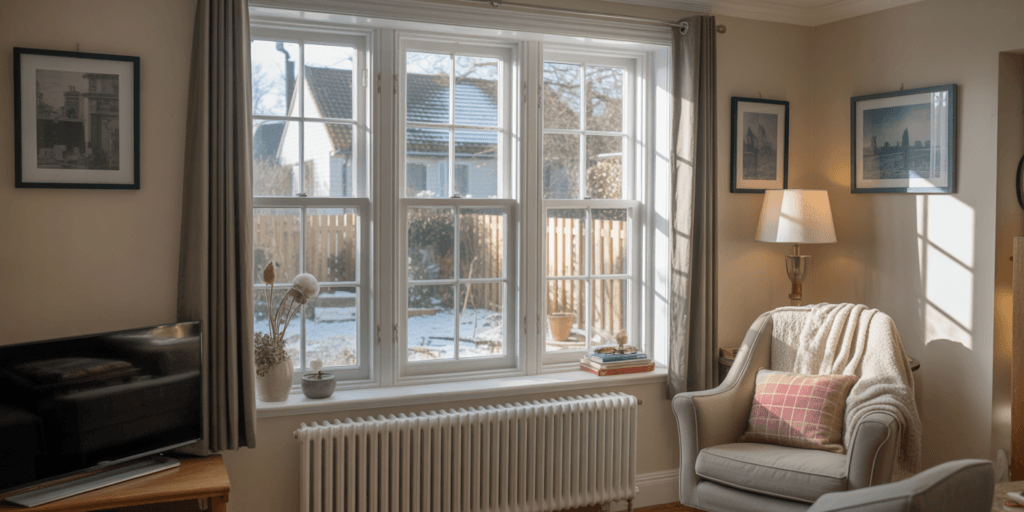The Myth of the Pane: Why U‑Values Aren’t What You Think
For decades, homeowners have been led to believe that window performance begins and ends with glass. Add another pane, they’re told — double it, or triple it — and efficiency will follow. It’s a simple message, and an incomplete one.
In reality, energy performance is not defined by glazing alone, but by the interaction of every element in the window assembly. The frame, the spacer, the perimeter seal, and the gas fill — each plays a critical role in determining how much heat is lost, and how much comfort is retained.
The industry seldom explains this. It’s easier to sell glass than to articulate system performance. But the result is familiar: homes across London fitted with high-spec units that underperform in practice — cold spots near windows, disappointing EPC scores, and rising heating bills, despite the brochure’s promises.
We’ve seen this scenario repeatedly at Sash Windows London. It isn’t that the client made a poor decision — it’s that they were given half the picture.
Before comparing specifications or quotes, ask this:
Are you being sold glass — or performance?
The distinction is more than semantic.
Glass alone can’t guarantee compliance. It can’t protect comfort. It won’t safeguard long-term value.
Only a whole-window performance system can do that.
That is where meaningful specification begins — and where the myth of the pane ends.
What Is a U‑Value — and Why Should You Care?
You can’t see a U‑value, but you can feel it every time you walk past your window on a cold morning. It’s the invisible number that decides whether your home holds warmth or leaks it.
In simple terms, a U‑value measures how easily heat escapes through a material. The lower the number, the better your insulation.
Think of it as a comfort index:
- A U‑value of 3.0 W/m²K (an old single‑glazed sash) means heat pours out like a sieve.
- 1.6–1.8 W/m²K (standard double glazing) holds heat better, but still leaks energy.
- 1.4 W/m²K or below meets modern UK Building Regulations — the legal baseline for new or replacement windows under Part L.
- 0.8–1.0 W/m²K (our advanced systems) moves you into passive‑house territory — homes that trap warmth so effectively they barely need heating.
But here’s the catch: most companies only quote the centre‑pane U‑value — the measurement taken from the middle of the glass unit, isolated from frame or seal. It looks spectacular on paper because the glass itself is usually the best‑performing part.
In reality, your home doesn’t have “just glass.” It has joints, spacers, gas gaps, frames, and seals — and that’s where the heat actually escapes.
The true measure is the whole‑window U‑value — a calculation that includes every component that transfers energy.
That’s the figure building inspectors look for. It’s the one that appears in Part L documentation. And it’s the only one that reflects how your window will really perform once installed.
At Sash Windows London, every specification we provide lists the verified whole‑window value — never the partial one. Because numbers should mean what you think they mean.
It’s how we protect not just compliance, but credibility.
And when you understand that the entire system defines efficiency, you’re ready to see why glazing composition, frame design, and installation detail matter far more than the number of panes in a brochure.
That’s where we go next — inside the anatomy of a truly efficient window.
Glazing Is Just One Piece — Meet the True U‑Value System

Ask most homeowners how they judge a window, and you’ll hear the same three words: double or triple.
It’s understandable. We’ve all been conditioned to equate more panes with more performance. But the truth is: glass is only one part of the story — and rarely the weakest link.
A window’s U‑value is defined not by one component, but by how every component works together. That includes materials you’ve never thought about, and details no brochure will tell you. Here’s what really makes a difference:
1. The Glazing Unit
Yes, glazing matters — but so does what’s between it.
- Low-E coatings (low emissivity) reflect heat back into the room.
- Gas fills like argon or krypton insulate better than air.
- Pane thickness and spacing affect sound, strength, and performance.
But glass alone can’t hold the line.
2. The Spacer Bar
This is the narrow band around the perimeter of the glass unit.
- Cheap windows use aluminium spacers, which conduct cold like a radiator fin.
- High-performance systems use warm-edge spacers — made from low-conductivity materials that help stop perimeter heat loss.
It’s a few millimetres wide, but it can swing your U-value by 0.2 points or more.
3. The Frame
Often the forgotten element, yet it can account for up to 40% of the window’s surface area.
- uPVC is cost-effective, but iit nsulates poorly and distorts with heat.
- Aluminium looks sharp, but requires a thermal break to perform.
- Engineered timber, used by Sash Windows London, offers natural insulation and longevity, especially when bonded with thermally resistant materials.
- Composite or alu-clad frames combine beauty, strength, and performance — ideal in conservation areas or exposed properties.
4. The Installation
No window is efficient until it’s properly installed. Period.
- Misaligned frames = air leakage.
- Gaps in the sealant = cold bridging.
- Incorrect fixings = warping under tension.
That’s why Sash Windows London trains its installers in airtight detailing, warm-edge integration, and passive‑standard seal protocols. A great window, badly fitted, is a liability.
Together, these four components create the real U‑value. And unless they’re all optimised, you’re only getting the illusion of efficiency.
That’s why at Sash Windows London, we don’t sell products — we design systems. Systems that pass Building Control first time. Systems that keep rooms warm at 2 am in February. Systems that don’t compromise heritage for performance — or performance for heritage.
Because when your window is built as a whole, everything performs better — including your home.
Why Triple Glazing Alone Doesn’t Guarantee Efficiency
Triple glazing sounds impressive. It’s a phrase that sells itself—three panes, more layers, must be better.
But here’s the truth: triple glazing is not a guarantee of thermal performance. In fact, many triple-glazed windows perform worse than well-built double-glazed systems when the frame, spacer, or installation fall short.
At Sash Windows London, we’ve worked on listed homes, passive new builds, and high-end retrofits. And across all of them, the same pattern emerges:
It’s not how many panes you have—it’s how well your system is designed.
More Isn’t Always Better
Adding a third pane increases weight, cost, and thickness. That matters—especially in conservation areas or heritage homes, where bulky units distort sightlines, increase frame profiles, and clash with planning requirements.
What’s more, not all triple glazing is created equal. Without:
- Low-E coatings,
- High-performance gas fills,
- Warm edge spacers,
- And most importantly,
- Thermally broken or low-conductivity frames, the performance gain of that extra pane can be negligible—or even reversed.
Precision Over Quantity
We’ve engineered systems with double glazing that outperform inferior triple-glazed setups—because the system was smarter.
- Precision-milled engineered timber
- Krypton-filled units
- Soft-coat low-E layers
- Warm-edge composite spacers
- Passive-class perimeter sealing
The result? Whole-window U-values below 1.0 W/m²K—surpassing Part L, improving EPCs, and delivering real comfort in real homes.
Aesthetics, Meet Performance
In many of our projects, triple glazing wasn’t even an option. Slim Georgian sightlines, sash weights, or listed-building requirements ruled it out.
But with clever glazing design and heritage-sensitive framing, we achieved the same thermal performance goals—without compromising character or compliance.
That’s why we approach every window as a bespoke thermal system, not a fixed menu of double or triple. It’s not about adding more—it’s about engineering better.
Summary Insight:
Triple glazing can be excellent—but only when it’s integrated into a performance-optimised system. Without that, it’s just expensive glass.
And if your installer or supplier can’t tell you the whole-window U-value, the conversation isn’t about performance—it’s about marketing.
Which is exactly what we help homeowners and architects rise above.
The Silent Heat Leak: Why Frame Material Matters More Than You Think
When people think about thermal performance, they think about glass.
When buildings leak heat, it’s often through the frame.
It may only take up a portion of the overall surface area, but the window frame is frequently the greatest source of thermal weakness—especially in poorly engineered or legacy systems.
In some units, the frame alone can account for 30%–40% of total heat loss.
And here’s the problem: most suppliers quote U-values based on the centre of the glazing, where the frame’s performance is excluded. The reality?
If the frame is cold, the window is cold—no matter how clever the glass.
So, what makes a frame thermally efficient?
Let’s break it down:
Timber Frames
- Natural insulator, low thermal conductivity
- Stable under load if engineered correctly
- Environmentally superior (renewable, breathable)
- Excellent lifespan when finished and maintained properly
Sash Windows London often specifies engineered timber cores, precision-treated and laminated to resist warping, movement, or decay.
uPVC Frames
- Widely used, but limited by size, rigidity, and aesthetics
- Insulates moderately well
- Can degrade or yellow over time
- Rarely accepted in conservation areas or high-end homes
A compromise on both performance and appearance in premium projects.
Aluminium Frames
- Strong, slim-profiled, ideal for modern aesthetics
- Terrible conductor of heat without thermal breaks
- Can lead to serious cold bridging and condensation risk
To perform well, aluminium must be thermally broken—a layer of insulation built between interior and exterior faces. This adds cost and complexity, and without it, aluminium frames can tank your U-value.
Composite & Alu-Clad Frames
- Combine timber interior with an aluminium or polymer exterior
- Offer the best of both worlds: internal warmth, external resilience
- Ideal for exposed properties or clients who want ultra-low maintenance without compromising internal feel
Sash Windows London’s alu-clad systems are designed to perform below 1.0 W/m²K, even in architecturally sensitive projects.
The Sash Windows London Approach
We don’t treat the frame as an afterthought — we treat it as the foundation.
- Every profile is modelled thermally
- Every joint is sealed passively
- Every frame is matched to the glazing and installation method
Because what wraps the glass often determines how well it works.
Summary Insight
You can spend thousands on triple glazing and still lose heat through a cold frame.
The smartest systems begin with the warmest structure.
That’s why, when we design windows, we start with the frame—not the glass.
Installation: Where Good Specs Go to Die

You can spec the best glazing. Choose the finest timber. Invest in low U-values and passive-ready frames.
But if your windows aren’t installed with absolute precision, all that performance is gone before the paint’s dry.
Thermal efficiency doesn’t live in theory — it lives in practice. And that practice lives in the hands of the person fitting your window.
Most heat loss doesn’t happen in the centre of the glass — it happens around the edges
The gaps. The seals. The interfaces between frame and wall. That’s where the draughts creep in.
And in most installations, these areas are rushed, undersealed, or simply misunderstood.
Common mistakes include:
- Improper sealing of the perimeter
- Thermal bridging through the fixing points
- Poor alignment, causing distortion of the frame or seals
- Incorrect packers or shims that interrupt the insulation zone
Each of these can add 0.2–0.5 W/m²K to your effective U-value. And that’s not a rounding error. That’s the difference between compliance and a fail. Between comfort and a cold draught at 2am.
This is where most window companies go quiet
They sell the glass. They quote the U-values. But the fitting is outsourced, often to subcontractors with little understanding of thermal bridging, airtight detailing, or passive-class standards.
You end up with a high-spec window undermined by a low-spec install.
The Sash Windows London Difference: Installation is Performance Engineering
We treat installation not as a final step, but as an integral part of the performance system.
Our trained fitting teams are specialists, not generalists. Every window we install follows strict protocols:
- Perimeter sealing with vapour control tapes
- Airtight membranes or expanding foams, chosen based on wall type
- Thermal break continuity from frame to building envelope
- Sightline alignment for both aesthetics and airtight integrity
We don’t leave performance to chance. We engineer it in, from the first fix to final sign-off.
Summary Insight
The highest-performing window on paper is only as good as its installer on the day.
Installation is not the end — it’s the make-or-break of the entire system.
That’s why we do it ourselves. That’s why it works.
Part L and the Future: Build for Regulation — and Beyond
Every homeowner today is a stakeholder in tomorrow’s regulation.
Whether you’re renovating a period property or building a new passive-standard home, there’s one common thread:
Your windows must meet — or exceed — the UK’s Building Regulations.
That begins with Part L: the regulation that sets the thermal performance standards for dwellings.
As of the 2022 update, any replacement or new window must achieve a whole-window U-value of 1.4 W/m²K or better.
It’s the legal minimum.
But for Sash Windows London, it’s just the starting point.
The U-Value Landscape Is Tightening
The government’s Future Homes Standard is already looming — and with it, an even stronger focus on:
- Carbon reduction
- Energy efficiency
- Passive-ready detailing
- Verified U-values, not brochure values
If your windows only just meet today’s standards, they’ll fall short tomorrow — devaluing your EPC, and potentially your resale.
That’s why more architects, developers, and high-end homeowners are future-proofing now.
Smart Investment Is About More Than Compliance
A better U-value does more than keep you legal:
- It cuts your energy bills — for years
- It boosts your EPC rating — increasing market appeal
- It enhances indoor comfort — less cold near the glass, no condensation
- It may unlock green finance or retrofit incentives
And for developers or landlords, it can also mean:
- Easier mortgage approvals
- Faster planning acceptance
- Higher resale and rental values
Thermal performance is no longer a spec line — it’s a property asset.
Sash Windows London: Over-Spec as Standard
We don’t design to scrape under the regulatory bar.
We design to exceed it — because performance is predictable when it’s engineered in.
Many of our window systems deliver:
- Double-glazed units with U-values as low as 1.0–1.2 W/m²K
- Triple-glazed and alu-clad systems at 0.8–1.0 W/m²K
- Fully compliant designs for Part L, Part Q (security), and Part K (safety)
- Bespoke integration with passive construction standards
And we don’t just supply the system — we install it to spec. No performance gap. No compliance surprises.
Summary Insight
Regulations are rising. Your expectations should too.
Don’t build for today’s minimum — build for tomorrow’s certainty.
And when you do, make sure your window partner is already there.
Ready to See Your Window’s True U‑Value?
You’ve seen how it works:
- U‑value is more than a number — it’s a system.
- Glazing alone doesn’t guarantee performance.
- Frames leak, spacers matter, installation is make-or-break.
- Regulations are tightening.
- And most suppliers are still quoting centre-pane figures that mask the truth.
At Sash Windows London, we don’t play that game.
We quote whole-window U‑values, because that’s what Building Control needs, and more importantly, that’s what your home deserves.
We design performance systems, not glass packages.
And we install them with passive-level precision, because every detail matters — right down to the tape behind the architrave.
So the only real question is:
Do you want windows that meet regulation — or ones that outperform it?
Are you buying specs — or investing in performance?
If you’re building, renovating, or replacing — this is your moment to move beyond the brochure, beyond the buzzwords, beyond just the glass.
Let’s Take the Next Step
Whether you’re a homeowner, architect, or developer, we offer tailored support for clarity and compliance:
- Book a U‑Value Performance Review → Speak with one of our technical advisors
- Submit Your Plans → We’ll analyse your glazing requirements and Part L obligations
- Download the Sash Windows London U‑Value Compliance Kit → Everything you need to understand how thermal design really works
- Request a Site Survey → Get a clear, no-obligation specification based on your property
Sash Windows London
Where craftsmanship meets compliance. Where thermal performance is designed, not guessed. Where you stop buying windows — and start building better.







